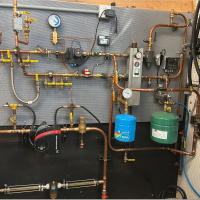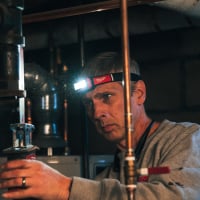Combi-Boiler Correct Sizing for Home
(Roof)- Metal roof, synthetic wrap, 5/8'' OSB, R38 insulation w/ blow in insulation in between, well-sealed, no access to attic space. 3 newly installed skylights very well sealed.
(Siding & Windows)- Vinyl siding and 7 windows (double pane and vacuumed that are well-sealed and insulated), house wrapped 3/4'' OSB sheathing, R19 batt insulation in exterior walls, 1/2" gypsum sheetrock for interior walls.
(Doors) - 2 doors w/ storm doors, composite frame, steel door exterior, insulated and well-sealed.
(Crawlspace) - Metal roof skirting exterior, house wrapped, insulated exterior walls and rim joists with R20 Owens Corning XPS foam board encapsulated and non-vented, sealed with caulking and canned spray foam. Rests on a concrete slab in very good condition. Less than 3ft in height and only for utility use. All water pipes insulated. Portable dehumidifier hooked up with automatic drain out.
(Flooring)- All vinyl plank flooring, no carpet.
If I'm missing anything or any of you need more information please let me know as I'd be more than glad to fill you in.
If any one could provide advice from their own experience or knowledge on my home's estimated heat loss and recommendations on specific brands or models of combi-boilers it would be greatly appreciated.
Comments
-
The first thing to do is to use this heat loss calculator: https://www.slantfin.com/slantfin-heat-loss-calculator/ to figure out how many BTUh you need to heat the house. Down at the bottom of the page there is a rather obscure "click here" which lets you run the calculations on a PC or Mac, or you can use it as an app on your smartphone.
It will also give you the heat loss for each room and -- if you want -- even tell you you much of Slant/Fin's baseboard you need (you can use other folks baseboard, though -- they won't mind!)
Then with your BTUh number from that you can select -- or your installer can select -- the correctly sized boiler for you heating load.
Now... you mention a combi. They can be a little problematic to size, as if your hot water load is large (not likely in a double wide but it might happen) it's hare to find one which is big enough for that and yet small enough to handle the heating load. Try not to oversize.
The most important thing on brands -- particularly for the newer modulating/condensing boiler and combis -- is whether the installer really understands and likes the system and can install it and adjust it correctly and keep it maintained. Also, make sure that when parts are needed that the supplier is close by.Br. Jamie, osb
Building superintendent/caretaker, 7200 sq. ft. historic house museum with dependencies in New England1 -
Space heating load is nearly irrelevant when talking combi units as the DHW load is almost always 2-3x the space heating load, but for discussion's sake, I also live in a 1400 sq ft double wide, in central MN, with similar specifications and mine is about 35,000 BTU at design (-20F). Where are you located, exactly? I send quite a few systems up around the Bemidji area and have others scattered all the way across the border from Lake of the Woods to Grand Marais, was just up in Cook last weekend and Ely the week before installing boiler systems. Anyway, if you're set on a combi, we'll want to figure out the DHW load before anything else. Worst case scenario, how much hot water would you ever be using at one time? Just 1 shower? 2 showers and laundry?5
-
Wow such a small world we live in. I'm located in Britt. Worst case scenario for water would probably be to have one or two showers running with laundry and/or dishwasher running too. However, I think that's a little overkill but safe for worst case scenario.0
-
If you can get @GroundUp to help you, @JohnJr , you'll be in good hands.
That's beautiful country up that way -- years ago I spent a good bit of time paddling around in that region...Br. Jamie, osb
Building superintendent/caretaker, 7200 sq. ft. historic house museum with dependencies in New England1 -
Wow, when I said Cook I was actually in Angora but didn't say it because nobody knows where it is haha. Was probably 10 minutes away from you at some point! Anyway, if we're shooting for worst case scenario and you've updated the showerheads to higher flow units, toward the end of the winter with the sub-50 degree water temps and say 2 GPM for each shower and 1 GPM for laundry, we're looking at 199,000 BTU unit which is huge for such a small home's space heating system. Personally, I don't like combi boilers or tankless WH in general for average household applications (heat-only boiler and indirect WH tank are a much better option IMO), but if you know that you want a combi I'd be happy to discuss this further with you. Would you be willing to sacrifice a little DHW production in order to make the boiler live a happier life? Say stepping down to a 150k or maybe even a 110k unit like a Lochinvar Noble (which is what I install, I feel they're the best combi currently available) for a more appropriate space heating size? The 199 would do a great job with the DHW but it may very well suffer with short cycling on warmer days without a buffer tank, which kind of defeats the purpose of a combi. What do you think?JohnJr said:Wow such a small world we live in. I'm located in Britt. Worst case scenario for water would probably be to have one or two showers running with laundry and/or dishwasher running too. However, I think that's a little overkill but safe for worst case scenario.
2 -
I would be willing to sacrifice a little DHW if it meant a longer life from the boiler. You also are the second person today to recommend a Lochinvar, but I have also been leaning towards the Navien NCB 210E. What are your thoughts on this model for my home and situation? Could you please explain in a little more detail how the combi would potentially short cycle on warmer days without a buffer tank? Is there any way to mitigate this without a buffer tank?0
-
0
-
On the short cycling, @JohnJr , what happens is that the lowest the boiler can go produces a certain minimum amount of heat -- but on a warm day your house can't absorb all that heat. So the boiler has to turn off. But then the house cools off a little and the boiler comes back on... and so on. Adding a buffer tank doesn't change the total run time much if any, but does allow the boiler to run longer -- and stay off longer -- which is better for it.Br. Jamie, osb
Building superintendent/caretaker, 7200 sq. ft. historic house museum with dependencies in New England0 -
My thoughts on combi boilers in general are not very positive, so please take this with a grain of salt, but I would sooner heat my home by rubbing sticks together and take cold showers for eternity than own a Navien combi. Again, merely a personal opinion, but I have junked easily 20x more Navien units than anything else combined since starting this business only 5 years ago. There are a handful of good ones too obviously, but the failure rate I see is ludicrous and I can't believe they're still in business. Jamie did a good job explaining the short cycling issue, but the answer to your question regarding the buffer tank is no. Unless you add a dump zone and shoot unwanted heat outside to prolong burn cycles.0
-
My nearly worthless opinion as another non professional homeowner is to listen to Groundup when he suggests a heat only boiler with indirect tank. Much more efficient, probably cheaper, and also more reliable. Less things to break.
Simple and reliable is the name of the game when its -20f outside.
Also I've been through MN a few times. Dated a girl that lived in Minneapolis 14 or so years ago. Beautiful state. A little cold for my blood tho. Last time I was there in winter I think the high during the day was like 2f.0 -
How is it that a boiler will run 2 to 3 times longer to heat the domestic water than to heat the space? It has to heat a lot more water to heat the space, no? All the water in the closed loop pipes and radiators?I'm not a plumber or hvac man and my thoughts in comments are purely for conversation.0
-
All the water in the closed loops and pipes isn't really all that much water. Of course that varies, but it's kind of surprising how little water is in a pipe -- to a first approximation, only a gallon or so in 100 feet of half inch pipe. So if there are let's say 10 gallons in the boiler, and 400 feet total of pipe and emitter (thinking baseboards here) you ay be looking at perhaps 15 gallons of water. An indirect water heater may have 80 gallons of water...
So there's a lot less water to heat the space than is accounted for by domestic hot water.
If it's a combi, you also have to consider that not only is there less water involved in heating the space, it's not flowing anywhere near as fast in most houses.Br. Jamie, osb
Building superintendent/caretaker, 7200 sq. ft. historic house museum with dependencies in New England0 -
Its also about the 'temperature rise" of the incoming water for the combi to achieve. What is temp of incoming well water in MN winter? 35-38F? Coming through at up to 5gpm! As opposed to water in a close heating loop starting near room temp-- like 68F.0
-
That's why combis and stand alone instant hot water heaters have such huge power requirements! Your example here, assuming 110 water is a usable definition of "hot" -- is going to take close to 200,000 BTUh output from the burner... enough to heat an average sort of 8,000 square foot house!psb75 said:Its also about the 'temperature rise" of the incoming water for the combi to achieve. What is temp of incoming well water in MN winter? 35-38F? Coming through at up to 5gpm! As opposed to water in a close heating loop starting near room temp-- like 68F.
Br. Jamie, osb
Building superintendent/caretaker, 7200 sq. ft. historic house museum with dependencies in New England0 -
Wow I feel better now, I thought I was the only dude that was anti-combi2
-
Reviving this post as I thought there are enough similarities, but happy to start a new thread if preferred.
Looking for a sense check and have some questions - I’m in the early stages of building a ~1300sf, 2BR 2 Bath cabin in northern Minnesota. Will be timber frame with SIPs, radiant slab heat, private well. Cabin will be used more in the summer months, with occasional (a few days/mo.) winter usage.
Questions:
- I appreciate the relative lack of love for combi boilers in general, but is my usage case as good as any? Space for utilities will be cramped, so I like the idea of a tankless option, and GC has suggested a combi as a good option.
- If a combi boiler does make sense, any thoughts on electric vs propane? I like the idea of utilizing off-peak electric rates, and all else equal prefer electric to propane, but want to overlay with a dose of common sense. I don’t have a huge preference for gas vs. electric range. With occasional power outages in the winter months, do I need to worry about freezing with the slab heat? I.e., do I need a dual fuel option, and if so does it just make sense to make propane the primary fuel?
- Is hydronic slab heating a better option than electric systems in this application?
- Is something like a Steffes thermal storage system something to consider?
Many thanks for any thoughts or suggestions!
0 - I appreciate the relative lack of love for combi boilers in general, but is my usage case as good as any? Space for utilities will be cramped, so I like the idea of a tankless option, and GC has suggested a combi as a good option.
-
Just a wild guess, but 1300 sq ft of well insulated home, maybe 15 btu/ sq ft. = 19,500 BTU/hr on coldest design day. A load calc is always a good first step.
A Lochinvar Nobel 110K combi turns down to 11,000, so it is not oversized to the heat load.
It should supply around 2 gpm of DHW continuously. It depends on the incoming water temperature.
The math for that is 500 X flow X temperature difference
So 2 gpm of 35° incoming to 120° hot is 500 X 2 X 85= 85,000 btu requirement. Keep in mind you mix some cold with that 120 to shower.
Most shower heads are 1.5 gpm, but even a higher flow, the combi would keep up.
So the combi or tankless limitation is how many fixtures you could run at the same times. With a small combi, a shower, maybe a hand sink or dishwasher.
The main thing to know with tankless or combi, they need to be descaled every so often. How often depends on water hardness and how much water runs through it.
LP is what you want, it would take a lot of power to run an electric tankless. Not really able to use off peak for DHW with a tankless or combi. They run when water flows or a heat call.
It takes a lot of insulated storage and space to leverage off peak for heating. If this is a summer cabin, I don't see much value in an large, expensive storage option?
A 6 Kw boiler covers that load, and a 40 gallon electric water heater is another less $$ option, if you electric rates are super low? That would require a 30A circuit for the water heater and a 40A for the boiler.
Bob "hot rod" Rohr
trainer for Caleffi NA
Living the hydronic dream0 -
during a winter power outage, neither propane nor electricity will work.
A combi if the goal is to save space, tank for performance.All that said - this seems like a strong case for a ductless/ducted heat pump. Open layout, little winter usage, efficient envelope, small square footage all doesn’t scream in-floor heating to me. Maybe using some electric in-floor in the bathrooms? A tight home will have low temp floor temps, so it’s not like you’ll have warm toes here
0
Categories
- All Categories
- 87.3K THE MAIN WALL
- 3.2K A-C, Heat Pumps & Refrigeration
- 61 Biomass
- 429 Carbon Monoxide Awareness
- 120 Chimneys & Flues
- 2.1K Domestic Hot Water
- 5.8K Gas Heating
- 114 Geothermal
- 166 Indoor-Air Quality
- 3.7K Oil Heating
- 77 Pipe Deterioration
- 1K Plumbing
- 6.5K Radiant Heating
- 395 Solar
- 15.7K Strictly Steam
- 3.4K Thermostats and Controls
- 56 Water Quality
- 51 Industry Classes
- 50 Job Opportunities
- 18 Recall Announcements




